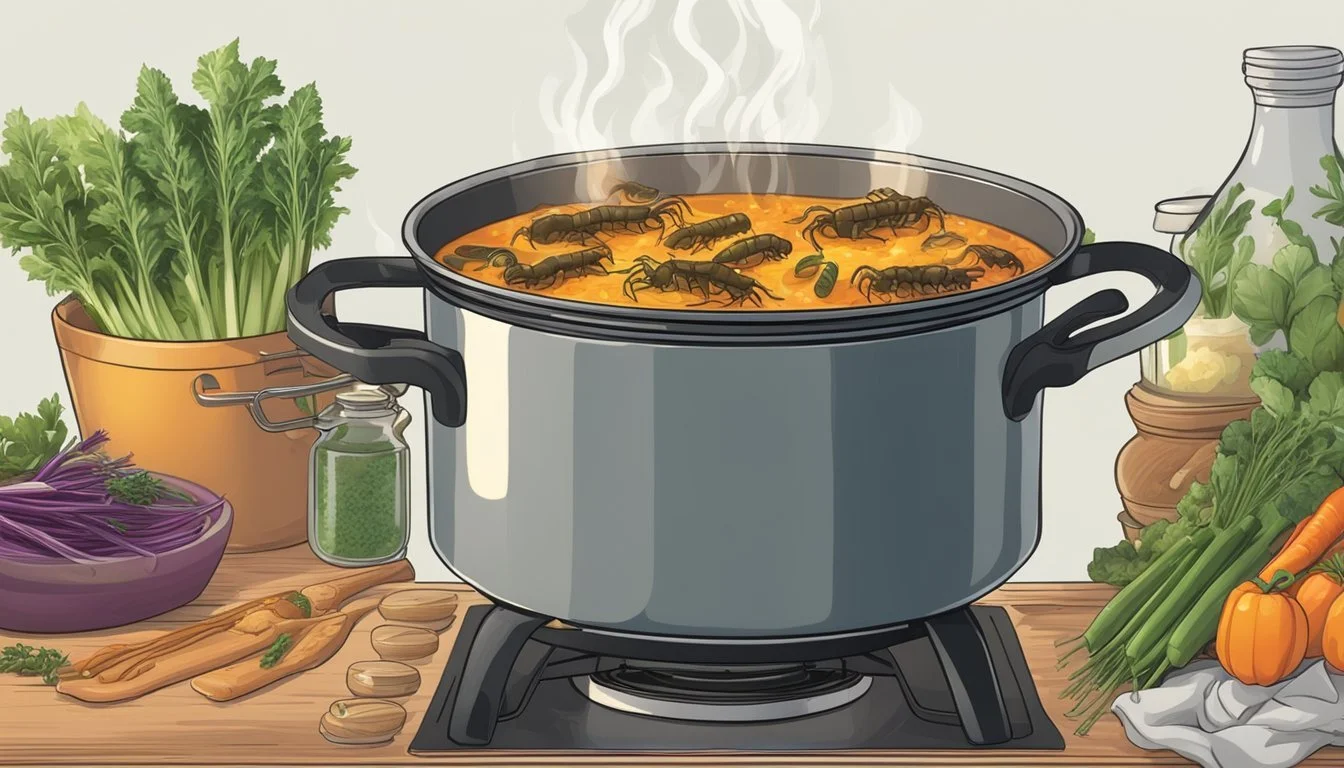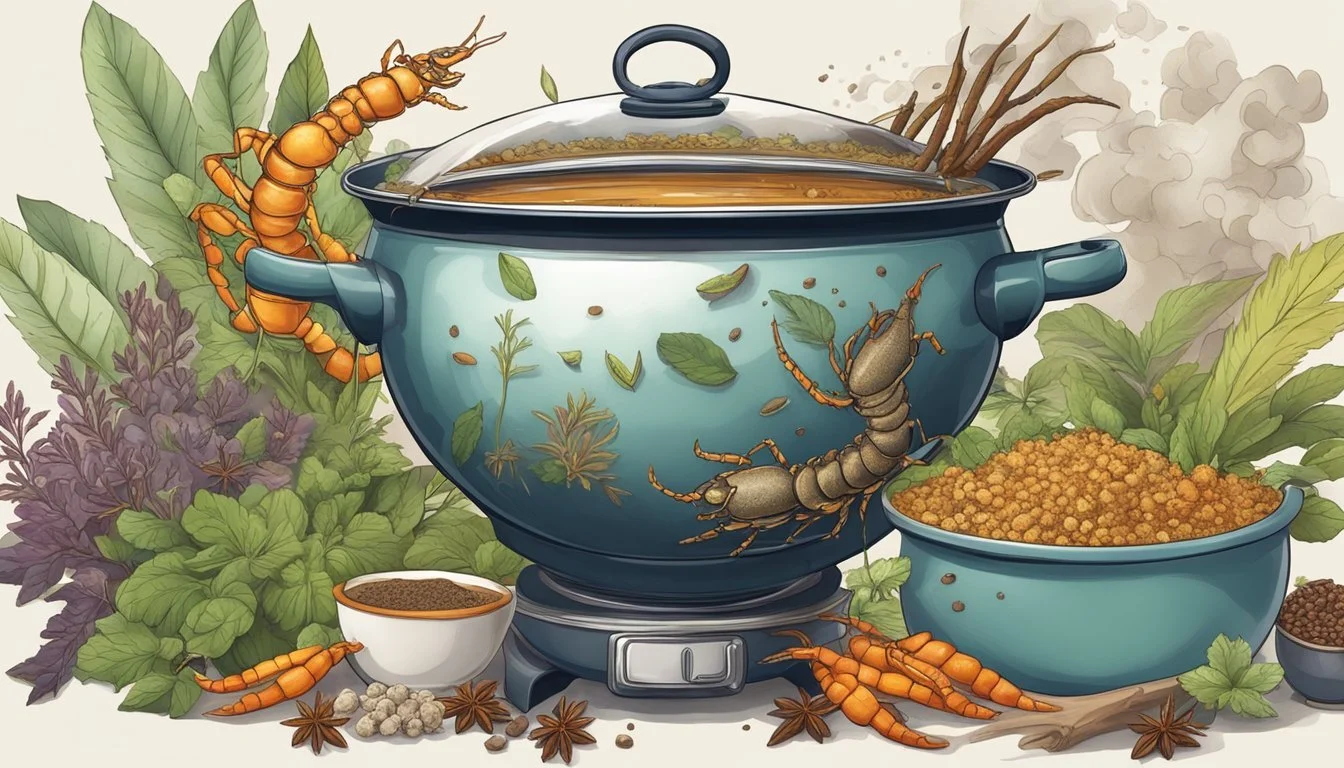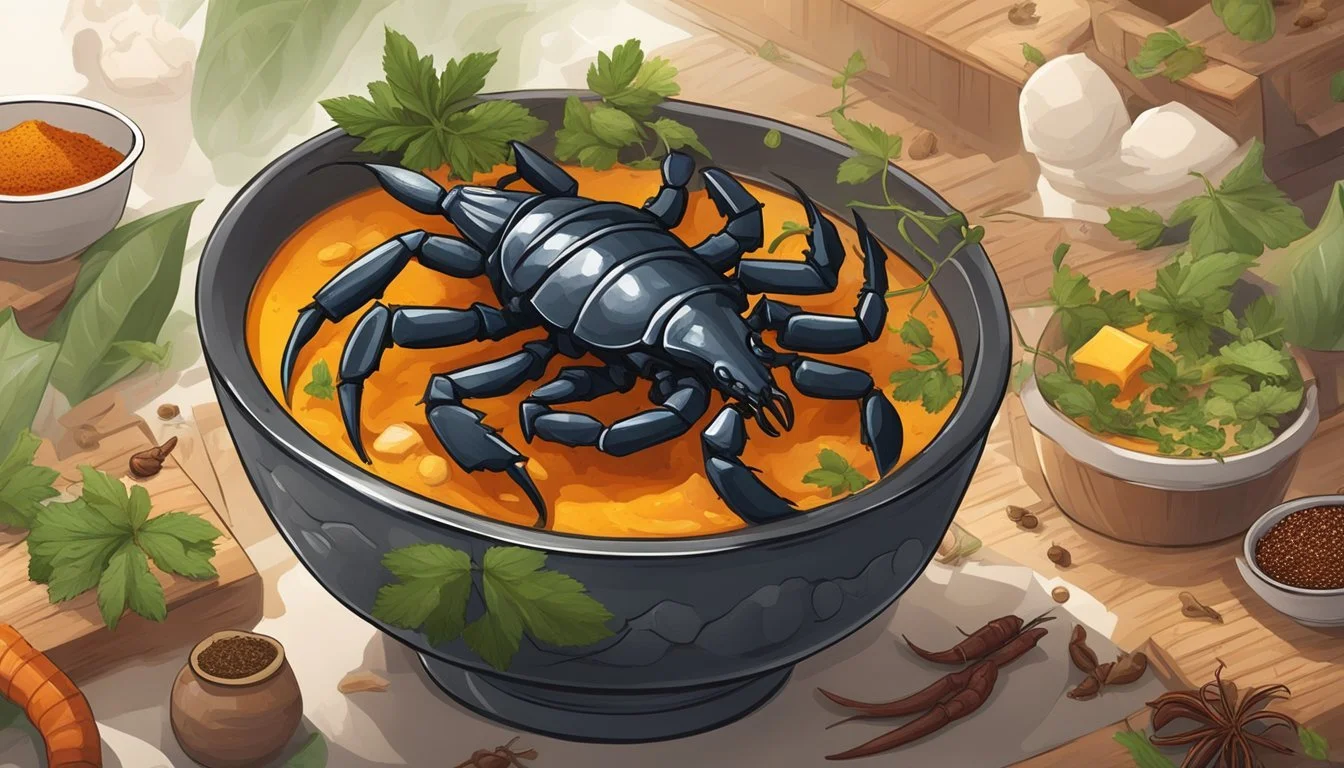Scorpion Soup Delicacy Unveiling China's Daring Culinary Experience
Scorpion soup is a distinctive dish that features prominently in the adventurous realm of Chinese cuisine, particularly in the southern regions. While it may seem exotic and intimidating to those unfamiliar with the gastronomic practices of this culture, the dish is known for its complex flavors and, surprisingly, its health benefits. Chinese food (What wine goes well with Chinese food?) enthusiasts often view the consumption of insects and arachnids as part of a rich culinary tradition that stretches back centuries. In this context, the inclusion of a whole scorpion in a soup is not merely a shock value ingredient; it is a continuation of a long-standing dietary practice that values a wide variety of natural ingredients.
The preparation of scorpion soup involves a meticulous process to ensure that the scorpion is safe to eat. Typically, the scorpion is included in the broth alongside other ingredients such as snake, pork, and vegetables, which all contribute to the soup's multi-layered taste profile. Diners are encouraged to approach the dish with an open mind, as the scorpion's texture and the overall flavor experience are quite unlike the typical fare found in Western diets.
Despite its daunting appearance, scorpion soup is enjoyed by many as a special dish, particularly praised for its supposed detoxifying properties. Its presentation, with the scorpion often visible in the serving bowl, provides a nod to the aesthetic importance in traditional Chinese plating methods. While scorpion soup might not yet be a global culinary phenomenon, it stands as a testament to the rich diversity and daring spirit of Chinese cuisine.
History and Origin of Scorpion Soup
Scorpion soup has a storied place in Chinese culinary history, deeply rooted in Guangdong province's tradition and widely recognized for its purported health benefits in Chinese traditional medicine.
Cultural Significance in Chinese Gastronomy
In China, particularly in regions such as Guangdong, traditional foods serve as a reflection of the country's rich cultural heritage. Scorpion soup is considered a classic dish within this tapestry, once reserved for the elite and now enjoyed by a broader spectrum of diners seeking to experience the full breadth of China's culinary legacy. As a traditional dish, it exemplifies the adventurous aspect of Chinese gastronomy, where diverse and exotic ingredients are embraced.
Traditional Medicine and Nutritional Value
In the realm of traditional Chinese medicine, scorpion soup is esteemed for its nutritional value and is believed to offer various health benefits. According to practitioners of Chinese traditional medicine, ingredients like scorpion are thought to have properties that can detoxify the body and enhance overall well-being. While Radii China acknowledges the soup for its uniqueness and as part of Guangdong's culinary customs, it is the nutritional value that garners interest for its role in traditional medicine. However, it is essential to note that the scientific community may not universally recognize these claims.
Ingredients and Preparation
The ingredients and preparation of Scorpion Soup are integral to achieving its unique flavor and texture. Specific proteins, vegetables, and a balanced blend of herbs and spices, paired with the proper stocks or broths, are the cornerstone of this traditional Chinese dish.
Scorpions and Other Proteins
In Scorpion Soup, scorpions are the primary protein, selected for their distinctive taste. They are detoxified before use to ensure safety. Additionally, proteins such as pork, chicken, or even snake can be included depending on regional variations and recipes. These meats are often stir-fried or simmered to tender perfection.
Vegetables and Aromatics
The inclusion of fresh vegetables such as bamboo shoots and aromatics like ginger and garlic provide depth to the soup. They are typically stir-fried in sesame oil to release their flavors before being added to the broth. Green onions might be used as a garnish, adding a pop of color and a mild onion flavor.
Herbs and Seasoning Spices
Herbs like Chinese yam and a mix of spices are used to season Scorpion Soup. Essential seasonings include salt and pepper to taste. These spices are often simmered within the broth to infuse the soup with their aromatic qualities.
Stocks and Broths
The foundation of any hearty Scorpion Soup lies in its chicken stock or chicken broth, which should be rich and well-seasoned. In some cases, a clear broth is prepared from pork bones or combined with other stock varieties to achieve the desired flavor profile. Stocks and broths are simmered to not only cook the added ingredients but also to meld the flavors together harmoniously.
Cooking Techniques
Proper cooking techniques are essential to enhance the flavors and textures of Scorpion Soup, a traditional Chinese dish. These methods ensure that the unique ingredients meld harmoniously to create a memorable culinary experience.
Marinating and Seasoning
Before stewing, the key proteins in Scorpion Soup—typically scorpion and sometimes snake—are marinated to deepen the flavors. Soy sauce and a blend of spices form the foundation of the marinade, providing a savory base that complements the meats’ natural tastes. The marination period allows the seasonings to penetrate the scorpion's exoskeleton, ensuring that every bite is infused with the intended flavor profile.
Stewing and Simmering
The proteins and vegetables are then left to stew slowly over a low heat. This cooking phase may last for at least three hours, allowing the ingredients, such as garlic, ginger, and spices, to simmer gently. The stewing process releases their juices, richly flavoring the broth. Patient simmering melds all the ingredients, marrying the complexities of each element into a cohesive dish.
Thickening the Soup
Once the soup has been sufficiently stewed, it may require thickening to achieve the desired consistency. Cornstarch is commonly used for this purpose. Cooking notes often suggest dissolving the cornstarch in a small amount of broth before adding it to the pot to avoid clumps and ensure a smooth texture.
Serving Suggestions
Scorpion Soup is typically served hot and is often considered best when enjoyed freshly made. The dish can be garnished with fresh herbs or a drizzle of sesame oil to accentuate its flavors. A bowl of steamed rice or a side of light vegetables can complement the hearty soup, balancing its robustness with simpler, cleaner tastes.
Health Benefits and Risks
Scorpion soup, a dish known in some regions of China, has been ascribed various medicinal qualities but also comes with potential health risks due to the toxins present in the creatures used.
Medicinal Qualities of Scorpion
Traditional Chinese Medicine (TCM) practitioners have attributed medicinal qualities to scorpions, believing they can detox the body and provide relief from ailments such as rheumatism, high blood pressure, and skin diseases. Some soups (What wine goes well with soups?) containing scorpion are said to aid in reducing the frequency of convulsions. The effectiveness of such treatments, however, is predominantly anecdotal, and scientific studies are limited.
Potential Health Risks from Toxins
The primary concern in consuming scorpion soup is the presence of toxins in scorpions. These toxins are part of the scorpion's venom, which may not be fully neutralized during the cooking process. Consumption of these toxins, especially if the scorpion hasn't been prepared correctly, can pose health risks and may provoke an allergic reaction or other adverse effects. Thus, it's crucial that scorpion dishes are prepared by knowledgeable chefs who understand how to reduce these risks.
Taste and Textural Experience
Diving into Scorpion Soup, diners are often curious about the unique sensory journey it presents. The dish promises a complex flavor profile with a textural contrast that defines its culinary character.
Description of the Flavor Profile
Chinese Scorpion Soup is renowned for its distinctive flavor; it combines elements of savory broths commonly found in traditional Chinese cooking with an added level of spicy zest that rouses the palate. Often harmonized with ingredients like snake meat and an array of Chinese herbs, the soup offers a taste experience that is described as rich and intricate. While snake meat contributes a tender taste, the scorpions are said to bring a more assertive flavor to the dish. They do not just add to the aesthetic of the dish but to the overall savor as well.
The spiciness of the dish is adjusted to preference, but it typically leans toward the spicier side to complement the robustness of the scorpions and snake meat. This dish is often perceived as nutritious, with the arachnids and snake meat providing an alternative protein source. Those who have acquired a taste for Scorpion Soup often find it to taste great and appreciate the skill involved in balancing the strong flavors.
Texture of Scorpion in the Dish
The scorpions, which are a unique element in this dish, add a textural depth that ranges from crunchy to somewhat gelatinous, depending on the cooking technique and the size of the scorpions used. Their exoskeleton gives a crisp aspect to the dish, contrasting with the tender texture of the snake meat. Below is a brief overview of the textural components:
Scorpion: Crunchy exoskeleton; can range from crisp to gelatinous innards
Snake Meat: Often tender, flaking apart easily in the hot broth
Patrons should be mindful when eating scorpions due to their hard exoskeleton which not only influences the texture but also makes them tricky to consume. Scorpion soup is not just about taste, but also the rich variety of textures that interplay with each bite.
Cultural and Seasonal Significance
Scorpion soup, a dish steeped in tradition, is valued in Chinese culture for its distinctive characteristics which align with specific seasonal contexts.
Winter Comfort Food
In Northern China, winter's cold grips the landscape, motivating the inclusion of warming dishes in local cuisine. Scorpion soup is believed to embody warmth, providing a hearty option for those braving the chill. The soup often features in winter meals, offering both physical warmth and a sense of comfort against the biting cold outside.
Celebratory Foods for Special Occasions
On special occasions, certain dishes such as scorpion soup take center stage, symbolizing more than sustenance but also good fortune and boldness. Consumed on hot summer days as well, the dish contrasts with the sweltering heat, suggesting boldness in both flavor and dining choice. The practice of consuming intriguing and often challenging dishes like scorpion soup reflects a culinary tradition that values unique experiences, especially during celebrations and festive times.
Regional Variations
Scorpion soup has its roots in the diverse culinary practises of China, where regional variations add local flavor and tradition to this unique dish.
Guangdong Specialty
In Guangdong, scorpion soup is a testament to the adventurous nature of Cantonese cuisine. The province is renowned for its willingness to include a variety of insects in its local dishes, and the scorpion is no exception. The soup typically integrates the scorpion into a broth that accentuates the texture and flavor of this unusual ingredient.
Other Chinese Regional Adaptations
Beyond Guangdong, regional adaptations of the scorpion soup can vary, though the core element—the scorpion—remains consistent. Each locale incorporates indigenous spices, techniques, and complementary ingredients that reflect the culinary identity of the region. Notably, some areas might infuse the soup with local medicinal herbs, adhering to traditional beliefs in the health benefits of consuming such insects.
Modern Interpretations and Fusion
Scorpion soup, a traditional Chinese dish known for its bold flavors, has evolved with modern culinary trends. Chefs and food enthusiasts are reinterpreting this classic soup, infusing it with new ingredients and techniques to cater to contemporary palates and dietary preferences.
Contemporary Takes on Traditional Soup
Chefs are integrating bolder and unconventional ingredients into Scorpion soup. Instagram feeds feature versions where traditional spices are intensified, or unusual garnishes are added to elevate the dish's visual appeal and taste. Fusion elements include the incorporation of regional flavors from other cuisines, creating a complex and modern dining experience.
Vegetarian and Vegan Versions
Vegetarian and vegan adaptations of Scorpion soup are gaining popularity as demand for plant-based dishes rises. These versions replace scorpions and other animal products with hearty vegetables and plant-based proteins. They replicate the dish's texture and flavor profile using ingredients like:
Mushrooms: for their umami and meaty texture.
Tofu: as a protein substitute.
Seaweed: to mimic the seafood flavor.
Adaptation in Western Cuisines
Scorpion soup's adaptability is evident in Western cuisines where it is being reimagined with locally available ingredients. While maintaining the essence of the original recipe, these adaptations often feature:
Local Herbs and Spices: changing the flavor spectrum.
Meat Alternatives: such as lab-grown proteins for ethical consumers.
Chefs are deconstructing and reconstructing the dish to resonate with Western diners while introducing them to the exotic allure of traditional Chinese flavors. These inventive interpretations showcase the balance between honoring a culinary heritage and embracing global influences.
Culinary Challenges and Expert Tips
The Scorpion Soup incorporates unique ingredients, posing challenges in both preparation and flavor balancing. Here, experienced cooks can find tips on handling scorpions, achieving a harmonious broth, and avoiding mistakes that can lead to an unappetizing result.
Handling and Cooking Scorpions
Preparation: Scorpions should be handled with care. They must be thoroughly cleaned before cooking, paying special attention to the removal of the venomous stinger.
Cooking Methods: Whole scorpions can be deep-fried or stewed. Deep-frying neutralizes the venom, and stewing releases their medicinal qualities into the soup.
Creating a Balanced Flavored Soup
Ingredients: A combination of snake, pork, garlic, ginger, spices, and vegetables provides a depth of flavor.
Cooking Notes: Stewing for at least three hours allows the flavors to meld, with the scorpions infusing the broth with their purported detoxifying properties.
Avoiding Common Pitfalls
Flavor Balance: Be cautious not to overpower the dish with too many spices, which may overwhelm the delicate flavors of the main ingredients.
Presentation: While scorpions add a dramatic flair, the final plating should be done in a way that does not discourage diners due to its appearance.
Related Dishes and Alternatives
In the diverse landscape of Chinese cuisine, Scorpion Soup stands out for its bold use of ingredients. Those interested in exploring similar culinary experiences may find the following traditional soups and takeout options intriguing.
Similar Traditional Soups
Chinese culinary traditions offer a variety of soups that, while less adventurous than Scorpion Soup, still provide an authentic taste of regional flavors. Hot and Sour Soup is a staple, known for its spicy and tangy profile, featuring ingredients like bamboo shoots, tofu, and sometimes seafood. It often includes scallions and cilantro as garnishes, contributing to its distinctive taste.
Another popular choice is Wonton Soup, which represents the soothing side of Chinese soups. This comforting broth typically contains delicate dumplings filled with minced pork, shrimp, or vegetables, and is garnished with leafy greens.
For seafood enthusiasts, soups enriched with various sea creatures can satisfy their cravings. These soups may incorporate a selection of shellfish, fish, and other marine delicacies, each lending its unique texture and flavor to the dish.
Street Stall Food and Takeout Options
Chinese street stalls and takeout spots are famous for offering an array of quick and flavorful dishes that cater to a busy lifestyle. Street food options often include bowls of steaming noodles, enriched with a variety of toppings such as sliced meats, vegetables, and dumplings. Noodles serve as a hearty base for these dishes, while the accompanying broths range from mild to intensely spiced.
Egg Drop Soup is another widely available takeout item, distinguished by its ribbons of beaten eggs in a clear, savory broth. Although simpler in composition, it stands as a comforting alternative to the more exotic scorpion-based offerings.
For those seeking an unusual takeout experience akin to Scorpion Soup, some vendors offer adventurous eaters the chance to try delicacies like soups that contain red centipedes, known for their medicinal properties in traditional Chinese medicine.
In summary, these alternatives and related dishes provide a spectrum of flavors and experiences, from the hearty and familiar to the exotic and daring, all retaining the essence of Chinese culinary artistry.
Cooking at Home
When attempting to recreate Scorpion Soup in a home kitchen, one must consider the availability of authentic ingredients and the necessity for safety. Substitutions may be made to preserve the spirit of the dish, and careful attention must be directed towards the technique to achieve an authentic flavor profile.
Ingredient Substitutions
Scorpions: It's essential to note that sourcing edible scorpions might be a challenge. They should be specifically farmed for culinary use. If unavailable, some may choose to omit them entirely or substitute less intimidating insects such as crickets which are more readily available in some markets.
Savory Broth: Should the traditional spices be difficult to find, use a combination of vegetable stock, shallots, and sesame seeds to replicate the complex flavors.
Sweet Version: A sweeter take on the soup can be achieved by adding a splash of sherry instead of chili oil, balancing the flavors with a hint of sweetness.
Home Cooking Tips
Broth Preparation: Start your soup with a solid base by carefully browning shallots in vegetable oil to add depth. Progress by building the broth with added spices and simmer to amalgamate flavors.
Safety: When using exotic ingredients, such as insects, it’s vital they are sourced from a reliable supplier to ensure they are safe to consume.
Consistency: If the soup needs to be thickened, a small amount of flour can be whisked into the broth, creating a silky texture without altering the flavor significantly.
Finishing Touches: Garnishing with toasted sesame seeds and a drizzle of chili oil just before serving can elevate the dish, bringing in a crunchy texture and a hint of heat.
By considering the above factors, one can bring a taste of this adventurous Chinese dish into their home kitchen, striking a balance between authenticity and practicality.












